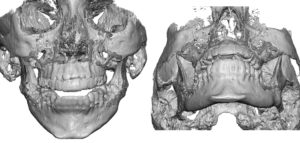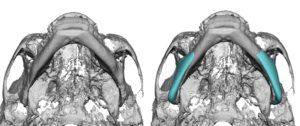Background: The jaw angle is the intersection of the vertical and horizontal components of the non-tooth bearing part of the lower jaw. Its development and size add a structural feature to the lower face whose prominence is usually viewed as a favorable feature for either men or women. Once developed the jaw angle bone changes little as one ages unlike the tooth bearing part of the lower jaw.
The well known sagittal split mandibular ramus osteotomy (SSRO) is the most commonly performed elective lower jaw osteotomy. Its primary purpose is to move the lower jaw forward or backward to improve the alignment of the dentition. In doing so the ramus (jaw angle bone) is split longitudinally into a proximal (tooth-bearing) and distal (joint containing) bone segments in a sagittal direction. It is an incredibly clever facial bone procedure that is highly effective.
But its execution requires repositioning and fixing together the two lower jaw bone segments in a new alignment. In addition the proximal bone segment (which constitutes the jaw angle) has extensive subperiosteal tissue stripping down on it to perform the procedure and thus undergoes some significant devascularization. Both maneuvers can cause potential shape changes of the jaw angle due to either a positioning change of the bone or loss of some bone due to resorption after surgery.



Highlights:
1) Sagittal split mandibular osteotomies have the potential to alter the shape of the jaw angle due to either segmental repositioning or some any resorption.
2) Secondary reconstruction of the atrophic jaw angle is best done by custom jaw angle implants.
3) The indwelling fixation hardware from the sagittal split mandibular osteotomy serves as a registration for custom jaw angle implant placement.
Dr. Barry Eppley
Indianapolis, Indiana







